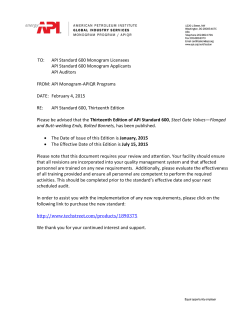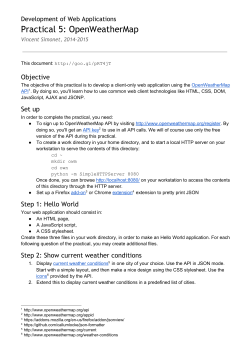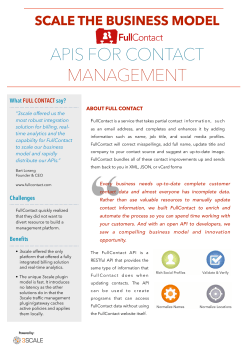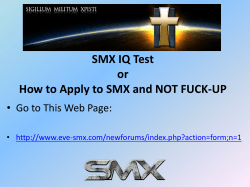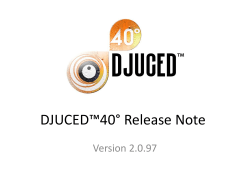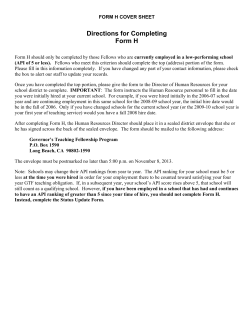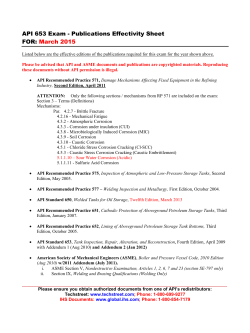
API Guide - SendGrid
API Guide | Contents 2 3 5 7 9 10 12 13 14 ↑Contents API Guide Introduction Event Webhook Parse Webhook Web API & Web API v3 Marketing Email API SMTP API Subuser API & Reseller API Resources Get Started | 1 API Guide Introduction SendGrid’s webhooks and application programming interfaces (APIs) extend the capabilities of our email platform, allowing users to quickly integrate with our system, measure delivery effectiveness, and expand the management of their email. After implementing our APIs and webhooks, users can have their applications parse emails, retrieve account statistics, see email events occurring in real-time, and specify custom-handling instructions for messages. This API Guide will describe how to maximize the capabilities of a SendGrid account. By using one, or even a combination, of our APIs and webhooks, users can tailor SendGrid to meet their specific business needs. What’s an API? API stands for Application Programming Interface, which is essentially a language and message that allows a program to retrieve information from a web application. Learn More: Webhook vs API: What’s the Difference Between Them? This guide provides: Overviews of each API and webhook Metrics, analytics, and use cases Hacks, tips, and tricks Additional resources and tools for extra learning We allow everyone to test, hack, and experiment with our entire Webhook and API library through our free accounts. Sign Up for Your Free Account and Start Experimenting Today ↑Contents | 2 API Guide Event Webhook With the Event Webhook, users can set up real-time notifications based on a variety of parameters and categories. Depending on how users configure the Event Webhook, they can view detailed information such as who opened which email or who clicked a specific link, as far back as their records go. This means that users can now see what happens to their messages AFTER they send them, rather than just know they’ve been sent out. The events that the Event Webhook can track include: Event Criteria Processed Message has been received and is ready to be delivered. Dropped Recipient exists in one or more of your Suppression Lists: Bounces, Spam Reports, Unsubscribes. Delivered Message has been successfully delivered to the receiving server. Deferred Recipient’s email server temporarily rejected message. Bounce Receiving server could not or would not accept message. Open Recipient has opened the HTML message. Click Recipient clicked on a link within the message. Spam Report Recipient marked email message as spam. Unsubscribe Recipient clicked on message’s unsubscribe link. When implemented, SendGrid will notify a URL of the user’s choice about the above events. Through customized reporting and relevant category and unique argument information, the Event Webhook potentially gives users the entire sending activity of their account and is not restricted by SendGrid’s internal storage limitations. ↑Contents What’s a Webhook? A webhook is an API concept that is also called a web callback, HTTP push API, or reverse API. Webhooks enable apps to push data to other applications as it happens in real-time. Learn More: What’s a Webhook? Learn More: The Event Webhook Guide provides more detailed information about how senders can use the Event Webhook in your application. Watch SendGrid’s video tutorial about how to set up the Event Webhook in just a few minutes. | 3 API Guide Additionally, as events are posted in real-time, users can have automated systems on their end take action. The Event Webhook enables users to: Automatically remove unsubscribes from the master mailing list. Associate a spam report with a specific campaign and user in an application. Know real-time when a user has clicked on a confirmation email. Get the specific link clicked on in an email. Get the browser version used by a customer. Know the specific MTA response for a customer. Quick Tip: The Event Webhook is great for accessing ongoing email activity data for reporting or trending purposes. Due to SendGrid’s volume, our Email Activity page holds records for two days with a maximum of 500 entries and our internal database records only go back about 30 days. For a more technical breakdown of how the Event Webhook works and how to implement it, visit the Event Webhook Documentation. See it in Action TheLadders use the Event Webhook to see which job seekers are engaged with each of their email streams to make sure they’re sending the best content possible. Learn more in their case study: TheLadders Have Found that SendGrid “Just Works.” Implement Faster: The open source EventKit App makes it even easier to implement the Event Webhook and learn what’s happening to messages. Read more in the EventKit section of this guide. ↑Contents | 4 API Guide Parse Webhook The Parse Webhook allows users to accept incoming emails from recipients, eliminating “no-reply” in the from-address. This encourages recipients to communicate with senders and improves engagement. SendGrid’s Parse Webhook works in a simple three-part process: 1. Recipient(s) replies to an email at the SendGrid user’s domain 2. SendGrid processes the email and extracts each part of the message 3. SendGrid POSTS each message part to a URL of the user’s choice Learn More: Our Parse Webhook Guide dives even deeper into the applications for this tool and provides additional examples of companies taking advantage of it. Watch this video tutorial to learn how you can set up the Parse Webhook in just a few minutes. ↑Contents | 5 API Guide Since the Parse Webhook can parse headers, subjects, body, attachments, and more from messages, it enables users to do a wide variety of things, including: Post blog articles via email. Process email replies and update mailing lists or databases. Upload pictures to social media profiles via email. Submit support requests via email. Track changes in user data in real-time using custom code. Automatically filter overtly “spammy” emails. Learn more about the different capabilities of the Parse Webhook and how to integrate it into your email program by visiting the Inbound Parse Webhook Documentation page. See it in Action The Parse Webhook can be used for a variety of applications. Read about how to use the Parse Webhook to have email replies read aloud in our blog post Get Your Mac to Speak Incoming Emails. Quick Tip: SendGrid automatically queues and retries unsuccessful POSTs that have responded with 4XX or 5XX statuses. This ensures that data isn’t lost if there are configuration issues with customer websites or POST URLs. Please ensure you grant a 200 OK status on a successful POST. Great Idea: Be practical. An expense-tracking system could allow users to email a list of purchased items to a specific email address. The Parse Webhook could extract the data and update the expense tracker seamlessly. Users don’t have to log onto their system and can easily update their expenses from their mobile phone. ↑Contents | 6 API Guide Web API & Web API v3 The SendGrid Web API allows users to pull information about their accounts, including statistics like bounces, spam reports, unsubscribes, and other information without logging into the SendGrid dashboard. Pull settings, statistics, and email reports into custom systems and unique user systems, rather than logging into the SendGrid dash. Use the Web API to send mail when output mail ports are blocked or when developing a library from scratch. Create and control subuser accounts for OEM setups. Learn More: To learn more about how to retrieve important information like bounces, blocks, and unsubscribes, or to see how our Advanced Suppression Manager can be implemented, visit the following pages: Build email interfaces within user systems for tighter integration with user platforms. Web API Overview Documentation Set up reports and have them sent to select recipients on a specific day or time. Web API v3 Overview Documentation The Web API allows users to perform any number of tasks, including: The Web API contains separate modules that enable you to retrieve key information on each email address including unsubscribes, blocked and invalid emails, bounce and spam reports, as well as statistics about a recipient’s ISP, device, and browser. The following lists the Web API’s endpoints. Module Description Bounce Retrieve and delete email addresses that have bounced from emails that you’ve delivered. Blocks Retrieve and delete email addresses that were blocked by their ISP. These emails are not suppressed and are just for information. Email Parse Add, edit, or delete your email parse settings. Event Notification URL Add, edit, or delete an event notification URL for your account. Filters View your available apps, edit their settings, and enable and disable them. Invalid Emails Retrieve and delete email addresses that you’ve sent to that are invalid email addresses. Profile Retrieve and update your profile information such as credentials and email address. Spam Report Retrieve and delete email addresses that have marked your emails as SPAM. Statistics Retrieve statistics on multiple metrics such as requests, bounces, spam reports, categories, and others. Unsubscribe Add, retrieve, and delete email addresses that were unsubscribed from your emails. ↑Contents | 7 API Guide We will also be making changes to the Web API in the near future. Over the last year, we’ve worked with customers to improve the functionality of SendGrid. Be on the lookout for this new version, Web API v3, so you can take advantage of: A more flexible, robust, and programmable API User-centric and tightly integrated user interface Ability to standardize return data patterns, response codes, and endpoint names See it in Action Bandsintown uses the SendGrid Web API to deliver personalized, geotargeted emails so their users will never miss another show. Read more in the blog post Personalization Can Turn Your Emails Into A Product Users Want. Quick Tip: The SendGrid Web API is not RESTful, since most calls for both GET and POST HTTP verbs can be used interchangeably, and other verbs are not supported. Great Idea: On all of our Web API Documentation reference pages, the “Try It” button allows users to turn the parameters table into a form that they can use to make actual Web API calls from the website. ↑Contents | 8 API Guide Marketing Email API The Marketing Email API allows users to programmatically interface with SendGrid for marketing emails. This API is very similar to the Web API. It follows the same format and convention, and it utilizes HTTP requests the same way. The Marketing Email API provides a way to manage marketing emails, lists, identities, and schedule delivery events. Some of the actions that can be performed with the Marketing Email API include: Upload, edit, and add email addresses to recipient lists. Pull email reports per list and manage multiple email templates. Segment lists and send to specific recipients or perform other testing strategies. Schedule batch messages at a specific date and time to your lists. The Marketing Email API is also great for organizations with technical and non-technical people working on email. Through the Marketing Email API, developers can retrieve data and analytics for marketers to interpret and then iterate on. See it in Action Learn More: SendGrid has modules to help you create and implement categories, lists, recipients, scheduled sends, and sender access. Visit the Marketing Email API Overview Documentation page. Quick Tip: Use A/B testing (also called split testing) to add variations todrafted marketing emails. Learn more about A/B testing in our guide Why A/B Testing is Critical to Email Campaign Success or visit the A/B Testing Documentation page. Pandora is just one of the great companies that sends their marketing email through SendGrid. See what we love about their messages in our post Personalized Music Metrics from Pandora. Great Idea: Instead of programmatically interfacing with the Marketing Email API, technical and non-technical stakeholders alike can use SendGrid’s Marketing Email Tool to compose and send scheduled marketing email campaigns. For a full walkthrough of this web and API-based user interface, visit the Create and Manage Marketing Emails Documentation page. ↑Contents | 9 API Guide SMTP API The SMTP API may be SendGrid’s most robust API. It allows users to deliver custom-handling instructions for email through a header inserted into the message labeled X-SMTPAPI. This header is a JSONencoded list of instructions and options for that message. The X-SMTPAPI header can be added to any SMTP message sent to SendGrid so that the message can be interpreted and applied. Handling instructions that can be included in the X-SMTPAPI header are: Apps - Also called filters, can be used to override filter settings already set up for the account. Categories -Allows you to track emails based on your own categorization system. Scheduling Parameters - Delay sending to improve mail flow and mail delivery time. Section Tags - Specific to the message, but not the recipient, these tags can be used to create extremely customizable emails for recipients. Substitution Tags - Specific for each recipient, these tags allow you to deliver dynamic content, like inserting the first name of a recipient in the greeting. Unique Arguments - Allow for even more detailed email tracking, like specific password resets or newsletter dates. IP Pools - Control the IP address that messages are sent from to dynamically segment mail streams. ↑Contents Learn More: For a walkthrough of the SMTP API, and some additional requirements and limitations of the API, just visit the Documentation page Using the SMTP API. Quick Tip: The custom X-SMTPAPI header added to messages will not be seen in the final email because it is an instruction header for SendGrid, and is stripped out of the final email. | 10 API Guide Through the X-SMTPAPI header, users are able to accomplish a wide variety of things with their email: Tag emails to get detailed statistics on each tag. Send multiple customized emails in one request via a mail merge. Configure each app on a per-email basis. Deliver dynamic content to your recipients in each email. Customize filtering instructions to control the amount and type of data you receive from each email stream. See it in Action See a great example of how to create a native app using Titanium Appcelerator and some SendGrid Apps (or filters) in the blog post Send Email with Titanium and SendGrid. Great Idea: Use the SMTP API to turn on/off email filters for select email streams, providing complete control and customization over email being sent. For example, users can remove unsubscribe functionality from the footer of internal system alert emails and turn off click-through data. ↑Contents | 11 API Guide Subuser API & Reseller API The SendGrid Subuser API and Reseller API are excellent Partner Program tools for users to set up child accounts for their customers to send email and view analytics, or to offer our delivery services to customers. Some of the partner programs these work well for include: Cloud Platform - Ideal for IaaS, MBaaS, PaaS, hosting, or other cloud stack services that want to provide email delivery solutions to customers. Marketing Solution - Build features or entire products on SendGrid’s email platform and let us take care of the backend work. Agency - Allow SendGrid to provide the robust email solution for client web and mobile applications. System Integrator - Perfect for software consulting firms and developer shops that need a cloud-based email infrastructure solution. Affiliate - The easiest way to partner with SendGrid and begin to leverage our industry-leading email delivery platform. Accelerate - SendGrid is happy to work with startup accelerators to support early-stage companies. To become a SendGrid partner, please visit the SendGrid Partner Programs page to learn more or Contact Us. See it in Action Read about how we’ve made it easier to deploy some of our main applications such as the SendGrid EventKit, Parse Webhook, and JavaScript. Read the blog post It’s Now Easier to Deploy Some Demo Applications With the Heroku Button. Great Idea: The Subuser API isn’t limited to Partner Programs. Many of our higher-volume users take advantage of the Subuser API and create child accounts to segment various types of email they send. To learn more about how to implement the Subuser API, please contact SendGrid Sales or Support. ↑Contents | 12 API Guide Resources The following resources are designed to help users take even more advantage of SendGrid’s APIs and webhooks. Whether it’s more information before implementing a new tool, or trying to troubleshoot a problem, the following links will help. As always, if you have more technical or account-specific questions, you can Contact SendGrid Support any time to get answers. Blog – The SendGrid Blog is the best place for staying up-to-date on everything email and SendGrid-related. Our posts range from email best practices tips, to technical tutorials for implementing new features, to announcements about product updates, or guest posts from partners. Check in often or subscribe to stay informed. Code Workshop – SendGrid’s Code Workshop is designed to make implementing code and integrating with the SendGrid platform as easy as possible. The Code Workshop tool allows you to select one of five different coding languages (C#, Node.js, PHP, Python, or Ruby) and then generate example code. This tool is great for creating SMTP API headers, creating message examples for multiple recipients, or showing examples of how to make attachments for messages. Documentation – SendGrid’s Documentation is where you can find more technical information about everything surrounding SendGrid accounts, APIs, and products. Whether it’s integration, determining what metrics mean, or definitions for email terms, our Documentation is where all this information lives, and it’s being updated constantly. EventKit – Our EventKit was created by SendGrid’s Support Incubator to help you take advantage of the Event Webhook as quickly and easily as possible. Developed in conjunction with a free Heroku account, the EventKit helps you set up the Event Webhook on your server and provides a reporting system. GitHub – SendGrid is a great believer in Open Source, so all of our API Libraries, SDKs, Apps, and even our Documentation can be found on our GitHub profile. Extensive documentation for each API Library can also be found in each relevant repository. Guides – Our other email best practice guides are excellent resources to have if you’re working on an email campaign. Our topics cover calls-to-action, design, deliverability, and even A/B testing. Knowledge Base – Our Knowledge Base is a collection of articles written and posted by SendGrid Support to answer common customer questions. This is a great place to look for answers for any account question, including those about IPs, apps, and even account billing. Support – We’re proud to have the best account and email support team in the industry. If you’re having any issues with your SendGrid account, you can feel free to contact us 24/7 via phone, chat, or email. ↑Contents | 13 Get Started with SendGrid Learn More Read Our Customer Success Stories Sign Up About SendGrid SendGrid helps you focus on your business without the cost and complexity of owning and maintaining an email infrastructure. We manage all of the technical details, from scaling infrastructure, to ISP outreach and reputation monitoring, to whitelist services and real-time analytics. We offer world-class deliverability expertise to make sure your emails get delivered, handle ISP monitoring, DKIM, domain keys, SPF, feedback loops, whitelabeling, link customization, and more. To learn more, visit www.sendgrid.com. ↑Contents
© Copyright 2025
